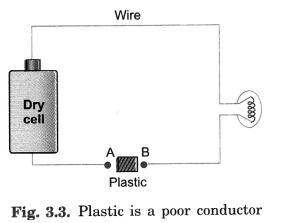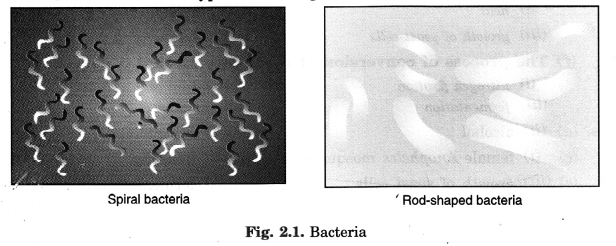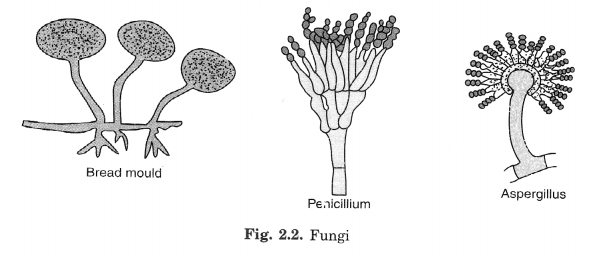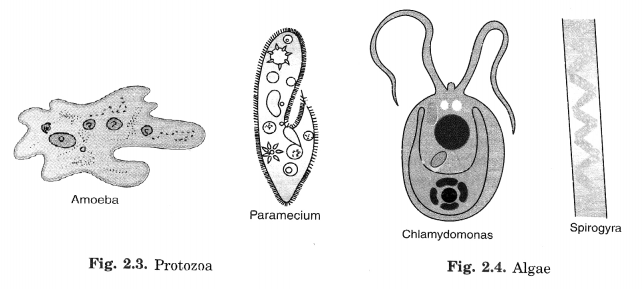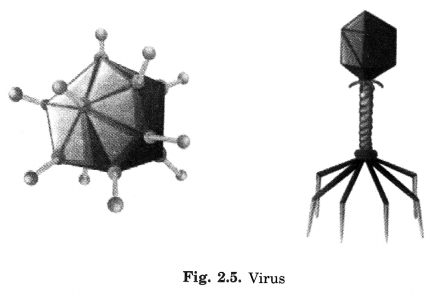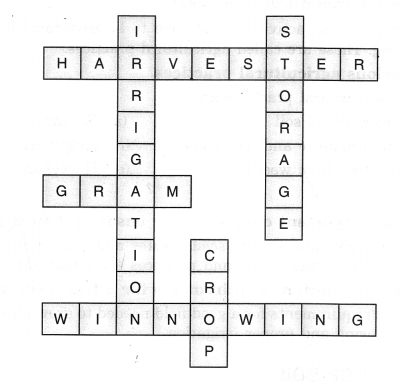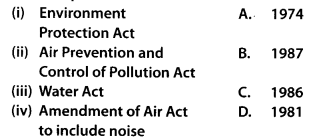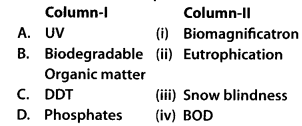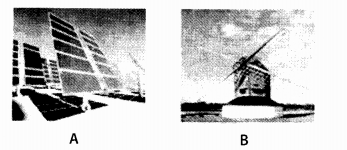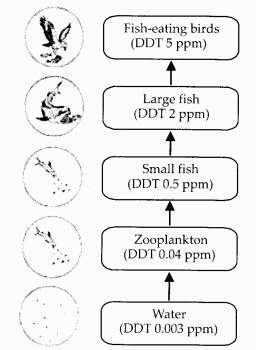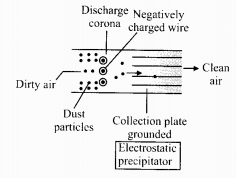NCERT Exemplar Solutions for Class 12 Biology chapter 15 Biodiversity and Conservation
These Solutions are part of NCERT Exemplar Solutions for Class 12 Biology. Here we have given NCERT Exemplar Solutions for Class 12 Biology chapter 15 Biodiversity and Conservation
Multiple Choice Questions
Question 1.
Which of the following countries has the hiqhest biodiversity?
(a) Brazil
(b) South Africa
(c) Russia
(d) India
Answer:
(a) : The environment of Brazil is characterised by high biodiversity. Brazil’s large area comprises different ecosystems, which together sustain some of the world’s greatest biodiversity. It has the most known species of plants (55,000), freshwater fish (3,000) and mammals (700). Birds and reptiles are also found in abundance.
Question 2.
Which of the following is not a cause for loss of biodiversity?
(a) Destruction of habitat
(b) Invasion by alien species
(c) Keeping animals in zoological parks
(d) Over-exploitation of natural resources
Answer:
(c) : Keeping animals in zoological parks is not a cause for loss of biodiversity rather it is a method of conservation of biodiversity.
Question 3.
Which of the following is not an invasive alien species in the Indian context?
(a) Lantana
(b) Cynodon
(c) Parthenium
(d) Eichhornia
Answer:
(b) : Lantana, Eichhornia and Parthenium are all exotic species, which had been introduced in India. Lantana camara has replaced many species in forests of Uttar Pradesh and Madhya Pradesh. Eichhornia (water hyacinth) has clogged water bodies including wetlands resulting in death of several aquatic plants and animals. Parthenium has pushed out several herbs and shrubs from open places in the plains.
Question 4.
Where among the following will you find pitcher plant?
(a) Rain forest of North-East India
(b) Sunderbans
(c) Thar Desert
(d) Western Ghats
Answer:
(a) : Pitcher plant is mainly found in rain forest of North-East India. This plant grows in the soil which has low nitrate. Hence, they obtain their nitrogen nutrition by trapping insects.
Question 5.
Which one of the following is not a feature of biodiversity hotspots?
(a) Large number of species
(b) Abundance of endemic species
(c) Mostly located in the polar regions
(d) Mostly located in the tropics
Answer:
(c) : Hotspots are areas of high endemism and high species richness. All over the world, some 34 such spots have been identified, including 3 in India (Western Ghats, Indo- Burma and Himalayas). The environmental conditions in polar regions do not favour large number of species or species richness.
Question 6.
Match the animals given in Column A with their location in Column B.
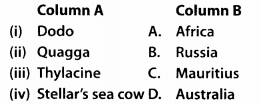
Choose the correct match from the following.
(a) i-A, ii-C, iii-B, iv-D
(b) i-D, ii-C, iii-A, iv-B
(c) i-C, ii-A, iii-B, iv-D
(d) i-C, ii-A, iii-D, iv-B
Answer:
(d)
Question 7.
What is common to the following plants: Nepenthes, Psilotum, Rauwolfa and Aconitum?
(a) All are ornamental plants.
(b) All are phylogenic link species.
(c) All are prone to over exploitation.
(d) All are exclusively present in the Eastern Himalayas.
Answer:
(c) : Nepenthes, Psilotum, Rauwolfia and Aconitum have either medicinal or ornamental importance. Hence, they are prone to over exploitation.
Question 8.
The one-horned rhinoceros is specific to which of the following National Parks?
(a) BhitarKanika
(b) Bandipur
(c) Kaziranga
(d) Corbett park
Answer:
(c)
Question 9.
Amongst the animal groups given below, which one has the highest percentage of endangered species?
(a) Insects
(b) Mammals
(c) Amphibians
(d) Reptiles
Answer:
(c) : The percentage number of endangered species in the list of threatened ones is 19% mammals, 17%birds, 21% reptiles, 22% amphibians.
Question 10.
Which one of the following is an endangered plant species of India?
(a) Rauwolfia serpentina
(b) Santalum album (Sandal wood)
(c) Cycas beddqmei
(d) All of the above
Answer:
(d)
Question 11.
What is common to Lantana, Eichhornia and African catfish?
(a) All are endangered species of India.
(b) All are key stone species.
(c) All are mammals found in India.
(d) All the species are neither threatened nor indigenous species of India.
Answer:
(d) : Lantana, Eichhornia and African catfish are exotic species or non-native species. Exotic species are often introduced for their economic and other uses. They often become invasive .and drive away the local species. These species are considered to be second major cause of extinction of species. Exotic species have proved harmful to both aquatic and terrestrial ecosystems.
Question 12.
The extinction of passenger pigeon was due to
(a) increased number of predatory birds
(b) over exploitation by humans
(c) non-availability of the food
(d) bird flu virus infection.
Answer:
(b) : Passenger pigeons (Ectopistes migratorious) were once one of the most abundant birds on our planet, living in North
AmeVica. But hunting on a very massive scale as well as deforestation, lead to their extinction. Many cruel ways were used for their hunting. The last individual of this species died in 1914 in Cincinnati Zoo.
Question 13.
Which of the following statements is correct?
(a) Parthenium is an endemic species of our country.
(b) African catfish is not a threat to indigenous catfishes.
(c) Steller’s sea cow is an extinct animal.
(d) Lantana is popularly known as carrot grass.
Answer:
(c) : Steller’s sea cow became extinct due to over exploitation by humans.
Question 14.
Among the ecosystem mentioned below, where can one find maximum biodiversity?
(a) Mangroves
(b) Desert
(c) Coral reefs
(d) Alpine meadows
Answer:
(c) : Coral reefs have the highest biodiversity with its macrobiota representing about 4-5% of the described global biota.
Question 15.
Which of the following forests is known as the ‘lungs of the planet Earth’?
(a) Taiga forest
(b) Tundra forest
(c) Amazon rainforest
(d) Rain forests of North East India
Answer:
(c) : Amazon rainforests are also called as the lungs of the planet earth. This rainforest in South America is the largest and most diverse tropical rain forest on our planet. It contributes around 20% of the total oxygen in our planet.
Question 16.
The active chemical drug reserpine is obtained from
(a) Datura
(b) Rauwolfia
(c) Atropa
(d) Papaver.
Answer:
(b) : Reserpine is an alkaloid that has been used as an anti hypertensive drug i.e., drug to lower blood pressure. It is obtained from the dried roots of Raiavolfia serpentina (Sarpagandha).
Question 17.
Which of the following groups exhibits more species diversity?
(a) Gymnosperms
(b) Algae
(c) Bryophytes
(d) Fungi
Answer:
(d)
Question 18.
Which of the below mentioned regions exhibit less seasonal variations?
(a) Tropics
(b) Temperates
(c) Alpines
(d) Both (a) & (b)
Answer:
(a) : There are no unfavourable seasons in tropics. Continued favourable environment has helped tropical organisms to gain more niche specialisation and increased diversity. Hence, tropics exhibit lesser seasonal variations.
Question 19.
The historic convention on Biological Diversity held in Rio de Janeiro in 1992 is known as
(a) CITES Convention
(b) The Earth Summit
(c) G-16 Summit
(d) MAB Programme.
Answer:
(b) : Earth Summit at Rio de Janeiro (1992), Brazil, promoted Convention on Biological Diversity (CBD) which was signed by 152 nations. Its recommendations came into effect on 29th December 1993. India became a party to this Convention on Biological Diversity in May, 1994.
Question 20.
What is common to the techniques (1) in vitro fertilisation, (2) Cryo preservation and (3) tissue culture?
(a) All are in situ conservation methods.
(b) All are ex situ conservation methods.
(c) All require ultra modern equipment and large space.
(d) All are methods of conservation of extinct organisms.
Answer:
(b) : Conservation of biodiversity can be broadly classified into two types : in situ (on-site) and ex situ (off site). Examples of in situ strategies include National parks, sanctuaries, Biosphere reserves etc. It is the preferred method to maintain species of wild animals in their natural habitats. This approach helps in conservation of total ecosystem. Ex situ approaches include conservation of those organisms, whose species may become extinct or decline heavily in number (due to a variety of reasons) in their natural habitat. This includes seed banks, cryopreservation, tissue culture, in vitro fertilisation etc.
Very Short Answer Type Questions
Question 1.
What characteristics make a community stable?
Answer:
Characteristics which make community stable are :
- Resistance to occasional disturbance (natural or man made).
- Resistance to invasion by alien species.
Question 2.
What could have triggered mass extinctions of species in the past?
Answer:
The exact reason for mass extinctions of species in the past is not known. Scientists however assume that drastic environmental changes that followed events such as asteroid or meteorite impact or volcanic eruptions lead to mass extinctions.
These environmental changes include fall in temperature causing global cooling that trapped sea water in polar ice caps leading to lowering of sea level; or rise in temperature leading to disrupted ocean circulation patterns, green house effect and depletion of ozone layer etc.
Question 3.
What accounts for the greater ecological diversity of India?
Answer:
Greater ecological biodiversity in India is due to greater geographical and topographical diversity in the form of rainforest, deciduous forests, temperate forests, deserts, mangroves, wet lands alpine meadows etc.
Question 4.
According to David Tilman, greater the diversity, greater is the primary productivity. Can you think of a very low diversity man-made ecosystem that has high productivity?
Answer:
Man made ecosystems like agricultural cropfields of wheat, maize, sorghum, paddy etc., show high productivity but low diversity.
Question 5.
What does ‘Red’ indicate in the IUCN Red list (2004)?
Answer:
Red’ being the sign of danger, in IUCN Red list (2004) indicates threatened species. These species are under various degrees of extinction risk.
Question 6.
Explain as to how protection of biodiversity hotspots alone can reduce up to 30% of the current rate of species extinction.
Answer:
Hotspots are the areas that are rich in species, have high endemism, and are under constant threat. Although it bears only 2.4% of land area of the world, but by protecting hotspots the current rate of extinction of species can be reduced upto 30%.
Question 7.
What is the difference between endemic and exotic species?
Answer:
Endemic species refers to plant or animal species that is restricted to one or a few localities in its distribution. Endemic species are usually confined to islands and are vulnerable to extinction whereas exotic species is a species of organism that is not native to a locality having been moved there from its natural range by humans or other agents. Some alien species, such as rats, are introduced mainly by accident in cargoes or transport vessels, while others are transferred intentionally, often for their ornamental or economic value.
Question 8.
How does species diversity differ from ecological diversity?
Answer:
Species diversity is the variety in the number and richness of the species of a region. Species diversity is product of both species richness or evenness or equitability, i.e., species richness weighed by species evenness. For example, big cats, like tiger (Panthera tigris), and lion (Panthera leo) belong to the same genus Panthera but they all differ at the species level.
Ecosystem diversity explains the diverse number of niches, trophic levels and various ecological processes that sustain energy flow, food webs and recycling of nutrients. Within the geographical area, there may be variable number of ecosystems/habitats.
Question 9.
Why is genetic variation important in the plant Rauwolfia vomitoria
Answer:
Rnumnifin vomitoria grows in different ranges of Himalaya. This plant is a source of an alkaloid ‘reserpine’ which has medicinal value. Genetic variation is important for potency and concentration of active chemical reserpine present in it.
Question 10.
What is Red Data Book?
Answer:
International Union of Conservation of Nature and Natural Resources which which is now called World Conservation Union (WCU) maintains a red data book or red list which is a catalogue of taxa facing risk of extinction.
Red list has eight categories of species:
- extinct
- extinct in wild
- critically endangered
- endangered
- vulnerable
- lower risk
- data deficiency
- not evaluated.
Question 11.
Define gene pool.
Answer:
The sum total of all the genes found in an inbreeding population is known as gene pool.
Question 12.
What does the term ‘frugivorous’ mean?
Answer:
The term frugivorous is used for fruit eating animals.
Question 13.
What is the expanded form of IUCN?
Answer:
IUCN stands for ‘International Union of Conservation of Nature and Natural Resources’.
Question 14.
Define the terms (1) Bioprospecting (2) Endemism
Answer:
- Bioprospecting refers to exploring molecular, genetic and species level products of economic importance.
- Endemism refers to presence of some species in particular region only and nowhere else.
Question 15.
What is common to the species shown in figures A and B?
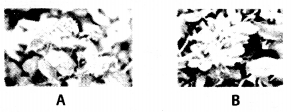
Answer:
Both are invasive weed species.
Question 16.
What is common to the species shown in figure A and B?

Answer:
Both are keystone species.
Short Answer Type Questions
Question 1.
How is the presently occurring species extinction different from the earlier mass extinctions?
Answer:
In earlier time, extinction of species occurred mainly due to natural causes or calamities like volcanic eruption, asteroid impact which lead to drastic environmental changes, etc., while at present human activities like deforestation, over-exploitation, pollution, intensive agriculture, introduction of alien species, etc., are the major causes of species extinction.
Question 2.
Of the four major causes for the loss of biodiversity alien species invasion, habitat loss and fragmentation, over-exploitation and co-extinctions which according to you is the major cause for the loss of biodiversity? Give reasons in support.
Answer:
Out of thy four causes for the loss of biodiversity, habitat loss and fragmentation seems to be the major cause of biodiversity losses. Loss of habitats result in annihilation of plants, microorganisms and forcing out of animals which in alien lands die out after some time. Fragmentation of habitats results in disruption of complex interactions amongst species, destruction of species in the cleared regions, annihilation of species restricted to deeper undisturbed parts of forests and decreased biodiversity in the habitat fragments. Animals requiring large territories (e.g., mammals, birds) are badly affected. Migrating animals would go astray and get killed.
Question 3.
Discuss one example, based on your day-to-day observations, showing how loss of one species may lead to the extinction of another.
Answer:
It has been observed that certain mutualistic relationships exist in nature. Extinction of one will automatically cause extinction of other. E.g., if the host fish becomes extinct, all the parasites exclusively found on it will also become extinct.
Question 4.
A species-area curve is drawn by plotting the number of species against the area. How is it that when a very large area is considered the slope is steeper than that for smaller areas?
Answer:
species-area relationship graph, Z is slope of line or regression coefficient which generally is 0.1-0.2 regardless of taxonomic group or region. When species area relationship is considered for a large area the slope of line becomes steeper having a value of 0.6-1.2. This is because the larger area has more food availability and other resources, so obviously more species can thrive there.
Question 5.
It is possible that productivity and diversity of a natural community remain constant over a time period of, say one hundred years?
Answer:
Although a typical community maintains itself, more or less in equilibrium with the prevailing conditions of the environment, in nature, communities are never stable; rather, they are dynamic, changing more or less regularly over time and space. They are never found permanently in complete balance with their component species, or with the physical environment. Environment is always changing over a period of time due to
- variations in climatic and physiographic factors, and
- The activities of the species of the communities themselves.
These influences bring about marked changes in the dominants of the existing community, which is thus, sooner or later replaced by another community at the same place.
Question 6.
There is greater biodiversity in tropical/ subtropical regions than in temperate region. Explain.
KPlffl
Higher diversity in tropical areas is because of the following reasons:
- Speciation is a function of time. Temperate areas have undergone frequent glaciation in the past. It killed most of the species. No such disturbance occurred in tropics where species continued to flourish and evolve undisturbed for millions of years.
- There are no unfavourable seasons in tropics. Continued favourable environment has helped tropical organisms to gain more niche specialisation and increased diversity.
- More solar energy is available in tropics. This promotes higher productivity and increased biodiversity.
- Resource availability is higher in tropics.
- There is reduced competition in tropics due to favourable environment.
- Rate of extinction is low in tropics.
Question 7.
Why are the conventional methods not suitable for the assessment of biodiversity of bacteria?
Answer:
All forms of bacteria cannot be cultured in normal laboratory conditions which creates a problem in studying their morphological and biochemical characteristics. Biodiversity can be studied by examining morphological and biochemical characters. Such conventional methods cannot be applied for assessment of biodiversity of bacteria.
Question 8.
What criteria should one use in categorising a species as threatened?
Answer:
A threatened species is one which is unable to realise its full biotic potential and is, therefore, liable to become extinct. The inability of realising full biotic potential is due to depletion of food, habitat deterioration, over-exploitation, alien species, etc.
Question 9.
What could be the possible explanation for greater vulnerability of amphibians to extinction as compared to other animal groups?
Answer:
Amphibians are the group of animals which can live both on land and in water. They do not have scales and their skin is permeable to gases. A vast majority of amphibian species have to maintain moist skin surfaces because a significant amount of breathing occurs through skin. They easily get affected by the fluctuations in the surrounding environment.
Their eggs lack shell and hence are prone to dessication in an unprotective environment. Variations in environmental patterns can affect their physiological and reproductive features thereby affecting the survival and continuation of their race which accounts for their greater vulnerability to extinctions as compared to other animal groups.
Moreover, as amphibians need both aquatic and terrestrial habitats to survive, threats to either habitat can affect their population. Hence, amphibians are more vulnerable to habitat modification than the organisms which require only one habitat type.
Question 10.
Howido scientists extrapolate the total number of species on Earth?
Answer:
Scientists make a statistical comparison of the temperate-tropical species richness of an exhaustively studied group of insects and extrapolate this ratio to other groups of animals and plants to come up with a gross estimate of the total number of species on earth.
Question 11.
Humans benefit from diversity of life. Give two examples.
Answer:
Humans derive numerous benefits from diversity of living organisms. These are discussed as follows:
(1) Useful products : Plant species provide a variety of useful products such as timber, crops, fruits and vegetables, gums, resins, dyes, fragrance, perfumes, waxes, lubricants, hydrocarbons, rubber, latex, tannins, paper, tea, coffee, dry-fruits etc. Animals like goat, hen etc., serve as good source of food to humans. Milk, flesh, honey, egg, etc. are all useful animal products. Similarly, animal species provide, wool, fur, skin, leather, lac, silk, waxes, lubricants, pearls, ivory, horns, antlers etc. Large number of substances with therapeutic properties are obtained from variety of plant species. For example, quinine is obtained from the bark of plant Cinchona to combat malaria; taxol from the bark of trees Taxus brevifolia, Taxus baccata for treating cancer; reserpine from Rauwolfia serpentina for treating blood pressure and schizophrenia.
(2) Indirect benefits : Oxygen which made the earth hospitable and is indispensable for survival of almost all living organisms comes from plants which release it in the earth’s atmosphere by the process of photosynthesis. Plants also help in maintaining water cycle, replenishment of water table, bringing rains, preventing soil erosion and flood etc.
Aesthetic values of various natural ecosystems provide the opportunity of ecotourism and hence means of earning to humans.
Question 12.
List any two major causes other than anthropogenic causes for the loss of biodiversity.
Answer:
Loss of biodiversity may be due to:
(1) Natural extinction – Species with small population are always in danger of extinction due to natural causes like inbreeding depression, increased number of predators, development of more competitive species and environmental fluctuations like severe drought, severe winter, harsh summer, excess rain, floods, etc.
(2) Mass extinction – Many species dis-appeared due to catastrophes like glaciation, volcanoes, meteoriteimpact etc. Mass extinction has occurred many times in geological history. E.g., disappearance of dinosaurs coupled with loss of more than 50% of the existing species at the end of cretaceous period.
Question 13.
What is an endangered species? Give an example of an endangered plant and animal species each?
Answer:
Endangered species are those species which are facing high risk of extinction in the near future due to decrease in their habitat and excessive predation or poaching. Example of endangered animal is red panda (Ailurus fulgens). Example of endangered plant is Lycopodium nutans.
Question 14.
What are sacred groves and their role in biodiversity conservation?
Answer:
Sacred groves are forest patches around places of worship which are held in high esteem by tribal communities. They are the most undisturbed forest patches (island of pristine forests) which are often surrounded by highly degraded landscapes.
Some examples of sacred groves are-
- Khasi and Jaintia Hills in Meghalaya.
- Aravalli Hills of Rajasthan.
- Sarguja, Chand and Batsar areas of Madhya pradesh.
- Western Ghats of Maharashtra and Madhya pradesh.
Role , of sacred groves in biodiversity conservation are as follows:
Sacred groves are serving as refugia for a number of rare, endangered and endemic species. Not a single branch is allowed to be cut from these forests. As a result many endemic species which are rare or have become extinct ‘ elsewhere can be seen to flourish here.
Question 15.
Suggest a place where one can go to study coral reefs, mangrove vegetation and estuaries.
Answer:
Place suggested for studying coral reefs is Andaman and Nicobar island. Mangrove vegetation can be well studied in West Bengal sunderbans and estuaries can be studied in coastal areas of Kerala.
Question 16.
1s it true that there is more solar energy available in the tropics? Explain briefly.
Answer:
Tropics lie on either side of equator between 30° south latitudes. It is limited in latitude by the tropic of cancer in the northern hemisphere and the tropic of capricorn in the southern hemisphere. The tropics include the areas on earth surrounding the equator where the sun reaches a subsolar point (a point directly overhead). These regions receive the most direct sunlight and heat energy from the sun and are the hottest.
Question 17.
What is co-extinction? Explain with a suitable example?
Answer:
When a species becomes extinct, the plant or animal species associated with it in an obligatory way also becomes extinct. This is called co-extinction. E.g., if the host fish becomes extinct, all the parasites exclusively found on it will also become extinct.
Long Answer Type Questions
Question 1.
Elaborate how invasion by an alien species reduces the species diversity of an area.
Answer:
Non-native or alien species are often introduced inadvertently for their economic and other uses. They often become invasive and drive away the local species. These species are considered to be second major cause of extinction of species. Exotic species have proved harmful to both aquatic and terrestrial ecosystems. This can be explained as follows:
Water hyacinth (Eichhornia crassipes) was introduced in Indian waters to reduce pollution. It has clogged water bodies including wetlands at many places resulting in death of several aquatic plants and animals. Nile Perch (a predator fish) was introduced in lake Victoria of South Africa. It killed and eliminated ecologically unique assemblage of over 200 native species of small cliched fish.
Question 2.
How can you, as an individual, prevent the loss of biodiversity?
Answer:
Biodiversity has great importance to mankind. But certain human activities are leading to biodiversity losses. In order to maintain biodiversity we all need to put an effort to save our ecosystem. Following measures can be undertaken to prevent biodiversity losses:
- Educate people about the importance of wildlife and their conservation.
- Implementing laws imposed by the government to protect biodiversity.
- Avoiding over-exploitation of natural re-sources.
- Promoting afforestation.
- Avoiding the introduction of alien species.
- Checking habitat loss and fragmentation of species.
- Reducing pollution, etc.
Question 3.
Can you think of a scientific explanation, besides analogy used by Paul Ehrlich, for the direct relationship Answer:
Species diversity is formally measured as an index combining numbers and proportion of each species present in an ecosystem. A species diversity index reflects the number of links in a food web. The relationship between species diversity and ecosystem stability has been the most studied and debated topic since 1950.
Paul Ehrlich in his rivet popper hypothesis tried to prove the dependence of ecosystem stability on species diversity. Another scientific explanation to his theory is as follows :
If we imagine that only one food chain is operating in an ecosystem where only one species is occupying each trophic level then this type of food chain is most susceptible to destruction as loss or extinction of any species can lead to destruction of other species dependent on it for food. On the other hand, if many alternatives are available at each trophic level in the food sequence a food web will be formed decreasing the dependence of a species on a particular species for food. Then even extinction of one species will not affect any other species due to availability of alternative food. That is why, in nature food chains never operate singly rather many food chains are interconnected to form food web which gives stability to the ecosystem.
Question 4.
Though the conflict between humans and wildlife started with the evolution of man, the intensity of conflict has increased due to the activities of modern man. Justify your answer with suitable examples.
Answer:
Since the humans evolved on earth, they have been exploiting wildlife for their survival and continuity. Initially the degree of exploitation of wildlife was very less but with increasing civilisation and modernisation, the humans are becoming more demanding. Their ever increasing population is inventing new ways for better survival and existence which at times are interferring with the ways of nature leading to extinction of wildlife species. Hence, the conflict between humans and wildlife continues and has been worsened.
This can be explained as follows:
(1) Destruction of habitat and fragmentation : Over-population, urbanisation and industrialisation require additional land every year. It can come through destruction or fragmentation of natural habitats of wild animals through filling wetlands, ploughing grasslands, cutting down trees, burning a forest and clearing some area of vegetation. Loss of habitat results in annihilation of plants, microorganisms and forcing out of animals Which in alien lands die out after some time. Fragmentation of habitats results in disruption of complex interactions amongst species, destruction of species in the cleared regions, annihilation of species restricted to deeper undisturbed parts of forests and decreased biodiversity in the habitat fragments.
(2) Indiscriminate hunting : Hunting of animals for food, hide, tusks, horn, at excessive levels may lead to species extinction. Dodo bird and passenger pigeon have already become extinct. Many species of fish, molluscs, sea turtle and whales are facing the risk of extinction.
(3) Introduction of alien species:
- Non-native or alien species are often introduced inadvertantly for their economic and other uses. They often become invasive and drive away the local species. These species are considered to be second major cause of extinction of species.
- Carrot grass has replaced herbs and shrubs of open spaces.
- Water hyacinth has become dominant species in pools and ponds.
- Pollution : Excessive use of pesticides has polluted both groundwater and surface 6. water bodies. Many sensitive species have disappeared.
- Intensive agriculture : Spread of agriculture is at the cost of wetlands, grasslands and forests. Destruction of habitats results in extinction of species. Intensive agriculture is also based on a few high yielding varieties. As a result, there is reduction in the genetic diversity. It increases vulnerability of the crop plants to sudden attack by pathogens and pests.
Question 5.
What is an ecosystem service? List any four important ecosystem services provided by the natural ecosystems. Are you in favour or against levying a charge on the service provided by the ecosystem?
Answer:
A wide range of economic, environmental and aesthetic benefits provided by ecolpgical process of an ecosystem are called ecosystem services. Services of healthy forest ecosystem are –
- Forests provide food in the form of roots, tubers, leaves fruits etc.
- They provide timber for building purposes of houses, ships, railway sleepers, sport good, agriculture tools etc.
- Number of useful products like camphor, essential oils, tannins dyes gums, resins, drugs are obtained from forests.
- Trees in forests produce oxygen during photosynthesis and keep environment cool by regulating transpiration and precipitation.
- Trees prevent soil erosion floods and provide shelter.
- Many insect pollinators help in pollination of plants thereby bring about flower and fruits formation.
- Microbes help in decomposition of waste products and recycling of nutrients. Ecosystem provides lots of services. Instead of putting a price tag or levying a charge against service a sincere effort should be made to protect ecosystem to continue its services.
Question 6.
Describe the consumptive use value of biodiversity as food, drugs and medicines, fuel and fibre with suitable examples.
Answer:
The consumptive use value of biodiversity as food, drugs and medicines, fuel and fibre has been described as follows :
(1) Source of food : Several thousand species of edible plants and animals are known. However, 85% of the world’s food production is met by cultivating less than 20 plant species. Three carbohydrate-rich crops namely, wheat, corn (maize) and rice alone yield nearly two-third of the food production. To meet the demands of increasing human population, man is not only exploring new varieties of plants but also animal food. Biodiversity is also used as a source material for breeding improved varieties. To improve the desired traits, commercial/domesticated. species are crossbred with their wild relatives.
In this way, disease resistant and high yielding varieties of crops (e.g.,wheat, rice, maize, sugarcane) and fruits have been developed. For example, cross breeding of wild rice species has helped ! in developing new varieties which are resistant to four main rice diseases. Similarly, potato has been made resistant to late blight disease, potato mosaic virus, five races of cyst nematodes etc., through crossbreeding experiments. Also, hybrid animals varieties have been produced to increase the production of milk, meat, eggs etc. This indicates the need for protecting biodiversity for breeding programmes in agriculture, horticulture, floriculture, animal husbandry, apiculture, sericulture, lac culture, piggery, poultry and fishery.
(2) Fibers : A variety of plant species such as cotton, flax, hemp, jut, Agave, etc., are the major sources of fibers. More and more variety of plants are being explored for obtaining superior fibers.
(3) Useful products : Plant species provide a variety of useful products such as gums, resins, dyes, fragrance, perfumes, waxes, lubricants, hydrocarbons, rubber, latex, tannins, paper, tea, coffee, dry-fruits etc. Similarly, animal species provide, wool, fur, skin, leather, honey, lac, silk, waxes, lubricants, pearls, ivory, horns, antlers etc.
(4) Drugs and medicines : Large number of substances with therapeutic properties are obtained from variety of plant species. For example, quinine is obtained from the bark of plant Cinchona to combat
malaria ; taxol from the bark of Taxus for treating cancer; morphine from Papaver somniferum for pains; reserpine from Rauwolfia serpentina for treating blood pressure and schizophrenia. Ayurvedic medicines available in the market for treating innumerous diseases in man are based on plant product.
(5) As fuel wood : 80% of forest wood (most trees) are used as fuel wood. E.g., Acacia nilotica, Albizzia sp. Mangifera indica etc.
Question 7.
Species diversity decreases as we move away from the equator towards the poles. What could be the possible reasons?
Answer:
Species diversity decreases as we move away from the equator towards the poles, because of the following reasons :
- Temperature decreases and conditions become harsh.
- Both the amount and intensity of solar radiation decreases.
- Limited resource availability.
- Higher competition due to unfavourable environment.
Speciation is generally a function of time and environmental stability, so if conditions are too harsh, it is difficult for species to survive.
Question 8.
Explain briefly the ‘rivet popper hypothesis’ of Paul Ehrlich.
Answer:
According to this hypothesis proposed by Paul Ehrlich (1981), the relationship between species richness and ecosystem functioning is non-linear, and may follow a variety of possible trajectories. The loss of a few species (or rivets holding together an aeroplane) will create no problem in the beginning, but beyond a certain point losses will cause catastrophic effect. Loss of rivets or key species that drive major ecosystem functions is a more serious threat for the ecosystem. Besides, the rich biodiversity is not only essential for ecosystem health, but imperative for the very survival of the human beings.
Question 9.
The relation between species richness and area for a wide variety of taxa turns out to be a rectangular hyperbola. Give a brief explanation.
Answer:
German naturalist and geographer Alexander von Humboldt while exploring the wilderness of South American jungles found that within a region the species richness increased with increasing area but upto a certain limit. The relationship between species richness and area turned out to be rectangular hyperbola for a wide variety of taxa Whether they are birds, bats, freshwater fishes or flowering plants. On a logarithmic scale it is a straight line and is represented by equation: log S = log C + Z log A

Here S is species richness, Z is slope of line or regression coefficient, C is Y intercept while A is area. The relationship between area and species richness in most cases is represented by a rectangular hyperbola which indicates that if we take a larger area under consideration then the number of species increases because more individuals get included in the sample and large areas are environmentally more heterogenous than small areas. But this increase in number is neither uniform nor unlimited. Ecologists have proposed wide range of factors determining the slope and elevation of species area curve. These factors include relative balance between immigration and extinction, rate and magnitude of disturbance predator-prey dynamics, etc.
We hope the NCERT Exemplar Solutions for Class 12 Biology chapter 15 Biodiversity and Conservation help you. If you have any query regarding .NCERT Exemplar Solutions for Class 12 Biology chapter 15 Biodiversity and Conservation, drop a comment below and we will get back to you at the earliest.
